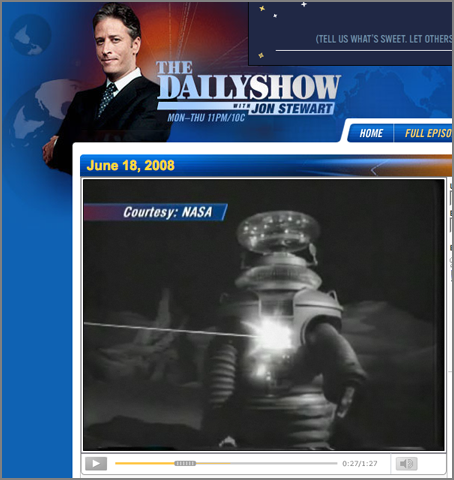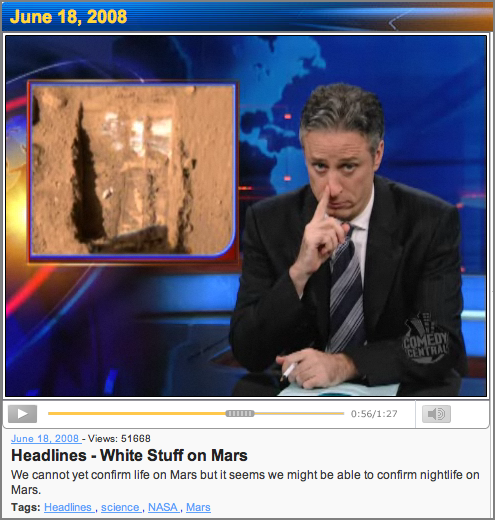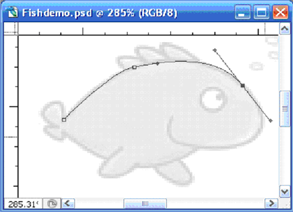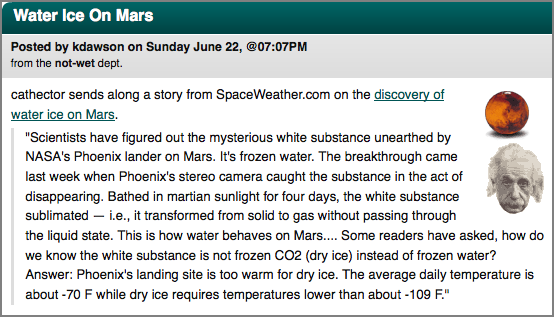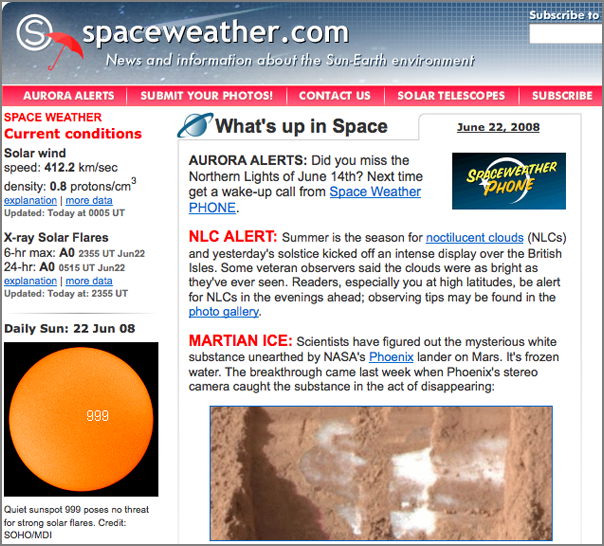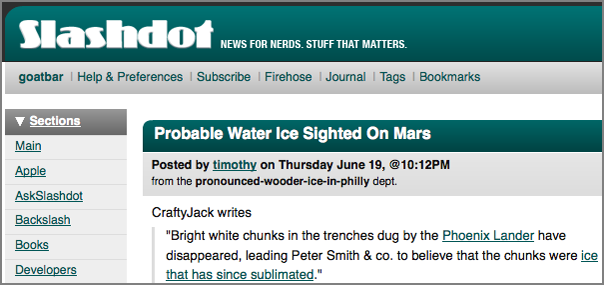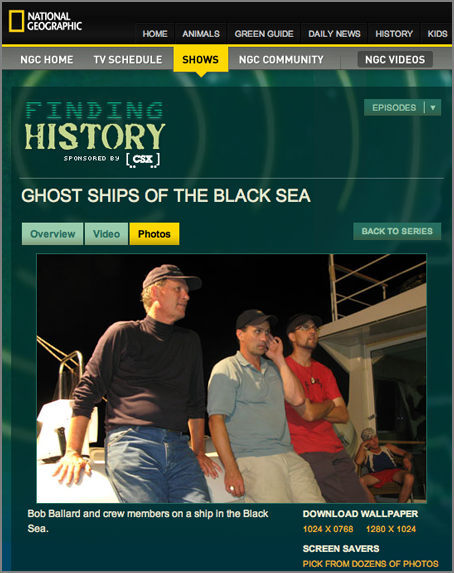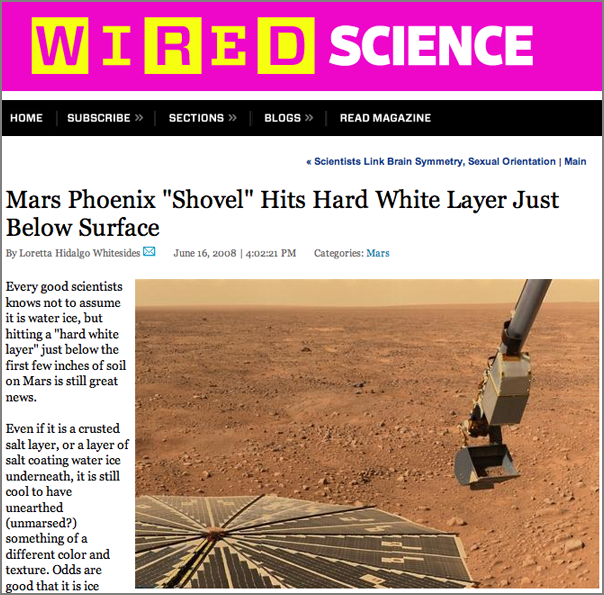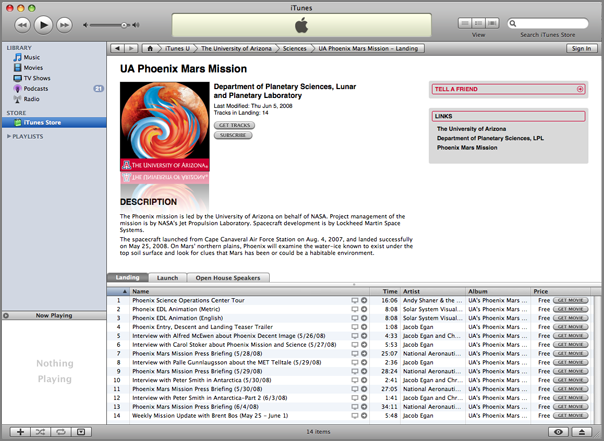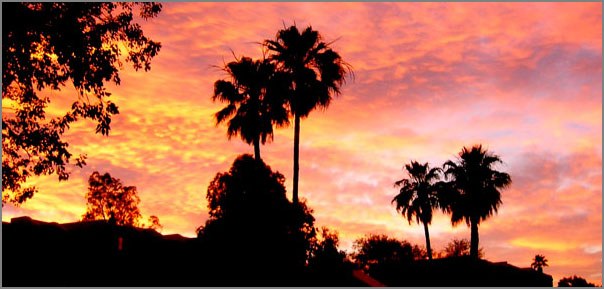06.30.2008 13:16
Phx in Scientific American
Pay Dirt: Martian Soil Fit for Earthly Life
Our Eyes on Mars: How the Phoenix Lander Sees
Our Eyes on Mars: How the Phoenix Lander Sees
... Scientific American spoke to Patrick Woida, who helped develop the imager to learn more about what makes the device see as we do. Woida is the SSI downlink engineer for the Phoenix lander, as well as a senior staff engineer at the University of Arizona's Lunar and Planetary Laboratory in Tucson. An edited Q&A transcript based on telephone and e-mail interviews follows. . How is the way the Surface Stereo Imager sees similar to the way that a human would see the surface of Mars? . Well, the imager is two meters off the ground, so that makes it about my height. [Woida is six feet, seven inches tall.] Also, the imager has two lenses that are set apart like eyes are on our faces. This arrangement allows for the imager to have depth perception like we have. Also, we aren't recorrecting the colors in images when they get sent back here to Earth. In other words, if you were standing there on Mars looking out, that's what you would see. ...
06.30.2008 11:16
Phx in Federal Computer Week
Thanks to Phil for this link:
Buzz of
the Week: Striking PR gold on the red planet [FCW]
... NASA has also learned how powerful its images from Mars can be. The space agency provided the public with an online view via NASA TV. NASA also broadcast video via Second Life, the virtual world created by Linden Research. Second Life users can view an avatar-sized full-scale model of the Phoenix launch vehicle, the Delta 2 rocket. The video feed included uninterrupted views of space, the Phoenix rover and mission control. . The space agency and its Jet Propulsion Laboratory, which handled coverage, did not provide a commentary track. Viewers got to listen to all the commands and drama of mission control unfiltered and uninterpreted. NASA also had public relations officials live-blog the process. . NASA headquarters spokesperson Dwayne Brown said the multimedia approach to covering the Phoenix landing gave the public a new perspective on how space missions work. "This is how you get the public excited and have them feel a part of something wonderful," Brown said. ...Hmm, I have to say that I don't know anybody that is very excited about this Mars Second Life stuff. However the twitter and blogs are popular. Would like to hear of articles that actually go into peoples' experience with the Phoenix 2nd life area.
06.28.2008 17:20
Penguins on Mars
Thanks to Jeff for pointing me to
this amusingly titled article.
Penguins on Mars?, Phoenix chemistry set discovers that Mars's soil is like Antarctica's by Katharine Sanderson [nature news]
Penguins on Mars?, Phoenix chemistry set discovers that Mars's soil is like Antarctica's by Katharine Sanderson [nature news]
Should we be looking for penguins on Mars, rather than little green men? Just a week after finding definitive signs of water ice just beneath the surface, news of another remarkable scientific discovery has been beamed back to Earth by the Mars lander Phoenix. . This time it's about muck. The soil under the lander was scooped up into its onboard chemistry lab just a few days ago, and subjected to a round of prodding, poking and other analysis. . And the results? Martian soil is like Antarctic soil. "This soil appears to be a close analogue to surface soils found in the upper dry valleys in Antarctica," says Sam Kounaves of Tufts University in Medford, Massachusetts, leader of the 'wet chemistry' portion of the Phoenix mission. ...
06.28.2008 11:11
new python template file
I've updated my python template file.
I copy/paste from this file all the time when coding python.
Suggestions are always welcome... there is always room for
improvement. This version adds svn propset notes, exceptions, time
formats, warnings, and command line choice options.
template.py
template.py
06.28.2008 10:09
Processing tide data
Monica talks about processing the
data from the tide station at Maine Maritime Academy:
Tide data filtering and the mysterious filtfilt issue [The
Moni-blog]
... used the convn function in Matlab in order to apply a convolution to the data. This filter can cause a phase distortion, however, by specifying the shape as 'same', the central part of the convolution is returned and the distortion is minimized. ...
06.27.2008 11:06
NASA Asparagus
Martian
soil good enough for asparagus: NASA by Jean-Louis Santini
[yahoo news]
Ground Control to Farmer Tom: asparagus on Mars? [UK times online]
Will NASA Ever Find Life on Mars? by Jeremy Hsu of space.com
... Kounaves said his team was "flabbergasted" at the results that came back. / "We basically have found what appears to be the requirements of the nutrients to support life, past, present or future," said Kounaves. ...
Ground Control to Farmer Tom: asparagus on Mars? [UK times online]
Will NASA Ever Find Life on Mars? by Jeremy Hsu of space.com
... But in the parlance of treasure hunters in the movie "National Treasure," this looks a lot like just another clue that will lead to other clues, and still more clues. The big question still hangs over NASA: Is there life on Mars? And just as important: Can NASA ever find the evidence for it? . Getting to that answer will require the right mission with the right tools in the right places - not to mention some serious digging beyond the capabilities of Phoenix. The next Mars missions include NASA's Mars Science Laboratory, an SUV-sized rover set to launch in 2009, and the European ExoMars rover that would wield a drill capable of digging 6.5 feet (2 meters) down. It is set to launch in 2013. ...
06.27.2008 07:13
Why powerpoint is not an image transport format
Powerpoint is a fine tool for making
presentations, but people always wonder why I tell them not to use
ppt to transfer images. Here is an example that I have from
yesterday. I crafted this image that is now released as: PIA10915:
Phoenix's Wet Chemistry Lab
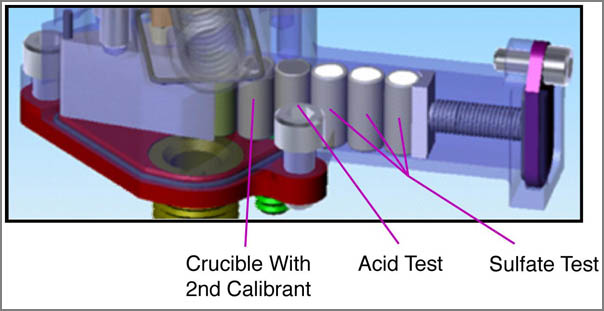
Here is the original that I had with a serious white dot problem. I traded this for a color problem with export or copy/paste that would have been uncorrectable.
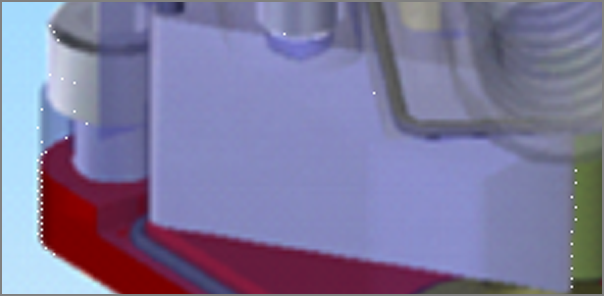
As you can see in the final, I got rid of most of the white dots, but I ran out of time, so I didn't get to the ones at the bottom.

Moral of the story: Don't give me a power point of the figure that you worked really hard on. Give me the original source images. Also, Illustrator PDF layer files are good, but if you make a PDF from PowerPoint that is even worse. PowerPoint is afflicted with a clipping plane problem where it puts in 50 billion clipping planes that I have to hunt down and remove/alter to transform a figure into a public web ready figure.

Here is the original that I had with a serious white dot problem. I traded this for a color problem with export or copy/paste that would have been uncorrectable.

As you can see in the final, I got rid of most of the white dots, but I ran out of time, so I didn't get to the ones at the bottom.

Moral of the story: Don't give me a power point of the figure that you worked really hard on. Give me the original source images. Also, Illustrator PDF layer files are good, but if you make a PDF from PowerPoint that is even worse. PowerPoint is afflicted with a clipping plane problem where it puts in 50 billion clipping planes that I have to hunt down and remove/alter to transform a figure into a public web ready figure.
06.27.2008 06:55
Phx Mars article roundup
NASA's
Phoenix Lander: 30 Days on Mars by Tariq Malik
[livescience.com]
Minerals Needed for Life Found on Mars [space.com]
Mars lander finds salty environment in taste test by Alicia Chang [AP/Boston.com]
Minerals Needed for Life Found on Mars [space.com]
... The results of both the TEGA and MECA tests are showing scientists that it's possible Mars may indeed have hosted, or be hosting, some form of life. . "Over time I've come to the conclusion that the amazing thing about Mars is not that it's an alien world but that it's actually very Earth-like," Kounaves said.
Mars lander finds salty environment in taste test by Alicia Chang [AP/Boston.com]
... "There's nothing about it that would preclude life. In fact, it seems very friendly," mission scientist Samuel Kounaves of Tufts University said of the soil. "There's nothing about it that's toxic." . Phoenix so far has not detected organic carbon considered an essential building block of life. Last week, the lander found evidence of ice below the soil. Scientists generally agree that liquid water, a stable energy source and organic, or carbon-containing, compounds are required for a habitable zone. ...For firefox 3 users: about:robots
06.26.2008 22:19
GeoCoastPilot (TM)
If you have Windows, give our
GeoCoastPilot a try:
GeoCoastPilot [ccom.unh.edu]
I run loaded it up onto a 12 inch Lenovo tablet and here it is in tablet mode:
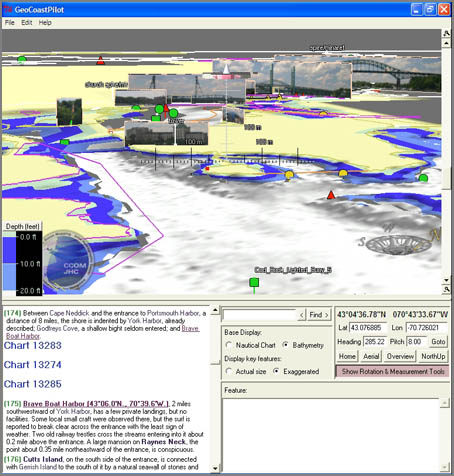
GeoCoastPilot [ccom.unh.edu]
I run loaded it up onto a 12 inch Lenovo tablet and here it is in tablet mode:

06.26.2008 16:12
Phx WCL - Wet Chemistry
Mars
Soil Appears To Be Able To Sustain Life [slashdot]
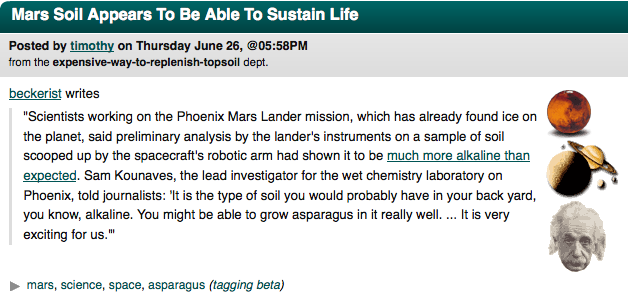
Phoenix sol 30 update: Alkaline soil, not very salty, "nothing extreme" about it! [planetary.org]
Phoenix Finds Earth-Like Soil On Mars [aviationweek]

Phoenix sol 30 update: Alkaline soil, not very salty, "nothing extreme" about it! [planetary.org]
Phoenix Finds Earth-Like Soil On Mars [aviationweek]
The Phoenix Mars lander, in its first series of soil chemistry tests, has discovered that Martian soil is remarkably Earth-like and could support a wide array of plants and organisms. . "I am flabbergasted by this data," says Samuel Kounaves, from Tufts University, the lead investigator on the Phoenix wet chemistry investigations. "If the data is sustained by other measurements, it will be an historic discovery relative to the search for life on Mars." . The highest scientific priority for Phoenix is to determine if the planet is habitable, at least in local areas, for the types of exotic plants and organisms that live in extreme environments on Earth. The mission has essentially achieved that goal with the first wet chemistry tests, Phoenix investigators said. ...
06.26.2008 13:15
Essentials for life available on Mars
Minerals
Needed for Life Found on Mars [space.com]
NASA's Phoenix Mars Lander found evidence of mineral nutrients essential to life in Martian dirt, mission scientists announced Thursday. . After performing the first wet chemistry experiment ever done on another planet, Phoenix discovered that a sample it dug of Martian dirt contained several soluble minerals, including potassium, magnesium and chloride. Though the data is preliminary, the results are very exciting, scientists said. . "We basically have found what appears to be the requirements for nutrients to support life," said Phoenix's wet chemistry lab lead, Sam Kounaves of Tufts University. "This is the type of soil you'd probably have in your backyard. You might be able to grow asparagus pretty well, but probably not strawberries." . Asparagus, which thrives in alkaline soil, would like the Martian dirt, which Phoenix measured to have a very alkaline pH of between eight to nine. Strawberries, meanwhile, like acidic soil, he said. ...
06.25.2008 08:08
datetime and time in python
>>>import datetime, time
>>>d = datetime.datetime.utcnow()
>>>d.strftime('%Y-%m-%d %H:%M:%S %z')
'2008-06-25 14:59:48 '
>>>t = time.localtime()
>>>time.strftime('%Y-%m-%d %H:%M:%S %z',t)
'2008-06-25 08:02:52 -0700'
In order to see the time zone, you need a timezone aware object.
Confusing.strftime behavior [python.org]
06.24.2008 22:28
Mac image capture
There are a number of image grabbers
for the isight (built in or external) out there for the Mac. It
seems very strange that Apple doesn't provide a simple command line
image grabber. DarwinPorts has a package of iSightCapture,
but that comes from the dmg. Today, I found isightGrab
that provides the source code, but is a little weird in the
licensing. It says in parts that it is the same as telekinesis, so
that would be the Apache License 2.0. If that is true, that I am
just about good to go to package it for fink as is, but I am not
happy with the current interface. For now, here is how to get and
build the program:
The license info:
svn co http://telekinesis.googlecode.com/svn/external/isightGrab
cd isightGrab
echo << EOF > Makefile
LDFLAGS := -framework Cocoa -framework QuickTime
SRCS:=${wildcard *.m}
OBJS:=${SRCS:.m=.o}
isightGrab: ${OBJS}
EOF
make
./isightGrab > foo.jpg
But the code is setup as a CGI, so it returns MIME type info that I
ripped out with emacs. This really needs two things. The first is a
command line interface (say using gengetopt or something similar).
The second is a clean python binding that returns a useful object
type. Those two things would really help out a number of
projects.The license info:
// brian whitman brian.whitman@variogr.am // uses Tim Omernick's CocoaSequenceGrabber which appears to have no license // license granted to whatever telekinesis usesCocoaSequenceGrabber
06.24.2008 19:01
Full color mosaic
A milestone for
the Phoenix mission success panorama [Planetary Society Weblog]
By Emily Lakdawalla
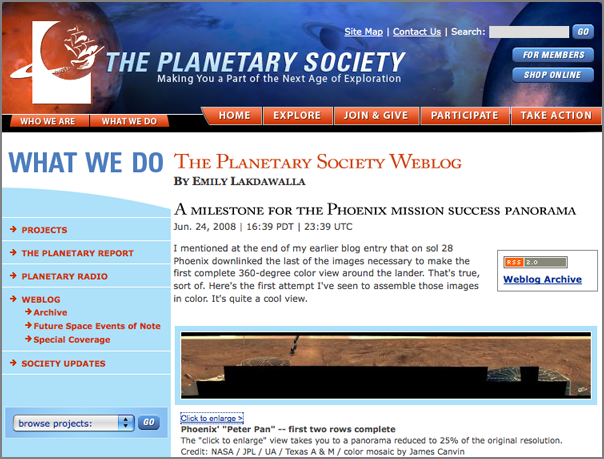

Phoenix camera team leader Mark Lemmon cautioned me that the mission success panorama isn't really quite done.
06.24.2008 15:40
Brightening another Phx Image
In Photoshop CS3,
Image->Adjustments->Shadow/Highlight. Then I did 50% shadows
and 0% highlights.
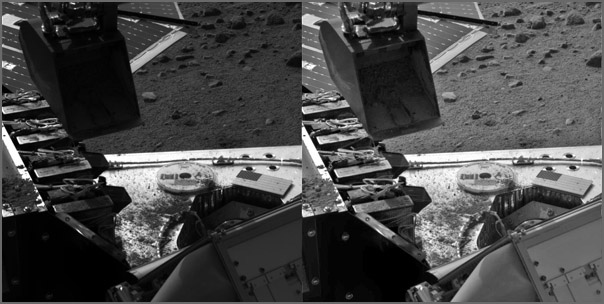

06.24.2008 12:57
Phx Update
Phoenix sol 29
update: Anomalies here and there, but minimum mission success is on
the horizon By Emily Lakdawalla [Planetary Society Weblog]
I just got off the phone with Phoenix mission manager Barry Goldstein,
who filled me in on what's been happening with Phoenix over the last
few sols. In a nutshell:
* The sol 22 anomaly is now understood; it was a two-part bug, the
first part of which was fixed with a software update uplinked
yesterday, so they may allow the scientists to start using flash
again today (in their plans for sol 30).
* They now think they understand the problem with the TEGA doors,
that it is a mechanical problem, that an assembly "was not
fabricated to flight specifications." However they still think
they can get samples in, and plan to try it on sol 30 or 31.
* The spacecraft went into safe mode and had no operations on sol
27, but they recovered fast and were back to normal on sol 28.
* They will probably deliver the first sample to the wet chemistry
lab nextersol (sol 30).
* Analyzing a second TEGA sample is the last item on the list for
minimum mission success, so that should be done by the end of
next week, and they're on track for full mission success by the
end of July.
...
Read on for a very detailed report.06.24.2008 08:07
Command line updating a Mac
I now run macs all across the
country. Updating them with remote desktop can be less than fun
with all sorts of firewalls and such. Apple does provide a way to
ssh into a box. First, see what needs installing:
And if you have to use remote desktop, here it the command to restart the program on a remote computer when the agent freaks out (which it seems to do on some computers)
% softwareupdate --list
Software Update found the following new or updated software:
* AirPortUtility_Leopard-5.3.2
AirPort Utility (5.3.2), 10780K [recommended]
* iDVD702-7.0.2
iDVD Update (7.0.2), 22390K [recommended]
* iMovie712-7.1.2
iMovie Update (7.1.2), 19780K [recommended]
Now do the install all (none of the above says it requires a
reboot. You can specify the name instead of -a to do just one.
% sudo softwareupdate -i -a waiting AirPort Utility waiting iDVD Update waiting iMovie Update Installing AirPort Utility 0..20..40..60..80..100 Done AirPort Utility Installing iDVD Update 0..20..40..60..80..100 Done iDVD Update Installing iMovie Update 0..20..40..60..80..100 Done iMovie Update Done.I got this from this site, but it works for normal (non-server) macs: Mac OS X Server: How to remotely install software using the softwareupdate command-line tool
And if you have to use remote desktop, here it the command to restart the program on a remote computer when the agent freaks out (which it seems to do on some computers)
% sudo /System/Library/CoreServices/RemoteManagement/ARDAgent.app/Contents/Resources/kickstart -restart -agentThis is from: Apple Remote Desktop: Configuring remotely via command line (kickstart)
06.23.2008 19:43
Whales in the courts
Supreme Court to hear case involving whales and Navy sonar
... The judge's order, which will stay in place for now, says the Navy may not use sonar within 12 miles of the California coast. Crews also must tone down their sonar whenever whales or other marine mammals are spotted within 2,200 yards of a ship. . But the justices said they will consider the Bush administration's contention that the judge overstepped her authority. . The case pits military readiness versus environmental protection. . On the one hand, the Navy says it needs to train crews in using high-powered sonar to detect submarines. Restricting the use of this sonar "jeopardizes the Navy's ability to train sailors and Marines for wartime deployment during a time of ongoing hostilities," Bush administration lawyers said in their appeal to the high court. ...
06.23.2008 17:22
Playing really large format movies on a Mac?
Hi all, I am trying to play movies on
a mac that has 5 projectors creating a 6400x1024 screen. I seem to
be running into all sorts of trouble with QuickTime and VLC. I get
white screens when playing and full screen is just screen 1. JPEG
compress renders visably but is just too bulky to play back. H.264
and MP4 are white.
What is the best way to make and play movies for this size screen with a 10.5.3 mac? I have movie frames on disk. This works, but is not a good solution:
What is the best way to make and play movies for this size screen with a 10.5.3 mac? I have movie frames on disk. This works, but is not a good solution:
xv -wait .25 -wloop -nodec frames*
06.23.2008 08:53
Orbcomm AIS satellite launched
Big news for AIS monitoring away from
shore: Wikipedia on
Orbcomm
Ship-Tracking Satellite Launched
ORBCOMM Announces Successful Launch of Six Satellites [business wire]
Ship-Tracking Satellite Launched
... The satellite, launched from Kapustin Yar, Russia, was equipped with automatic identification system technology capable of tracking and identifying ships...Russia launches US satellites [ukpress]
ORBCOMM Announces Successful Launch of Six Satellites [business wire]
... The Coast Guard and five Quick Launch satellites will be positioned optimally to augment the existing ORBCOMM constellation, providing additional capacity and improved message delivery speeds for current and future ORBCOMM users. In addition, these satellites are equipped with Automatic Identification System (AIS) payloads which will enable them to receive and report AIS transmissions to be used for ship tracking and other navigational activities. ORBCOMM has been working closely with the US Coast Guard on the AIS project, and also intends to market AIS data to other U.S. and international government agencies, as well as to companies whose businesses require such information. ...PTR Group Developed Flight Software On-Orbit With ORBCOMM Multiple Satellite Launch [tmcnet.com]
... The Coast Guard Demonstration and Quick Launch satellites have the capacity to enhance ORBCOMM's network performance. The satellites were launched into an optimum orbit to augment current satellites that would provide faster message delivery for the ORBCOMM's new and existing customers, said the company. Both the satellites are equipped with Automatic Identification System (AIS) payloads which enable them to receive and report transmissions from AIS-equipped maritime vessels. AIS payloads is an important component of the Coast Guard's monitoring; hence for the security and protection of nation's ports and waterways. The PTR Group, owing to its expertise in the area of VxWorks(R)-based real-time flight software development, worked closely with ORBCOMM systems engineers on the development of both the AIS and network communications software for these satellites. ...
06.23.2008 07:09
San Diego underwater autonomous vehicle (AUV) competition
A few years back, I went all to check
out this out when Sib was a judge. Pretty darn impressive what
these students pull off! Well worth seeing if you have the time and
are in the area.
Underwater Robot Competition [hydro international]
Nearly 60 student teams from all over the world will compete in underwater missions using underwater robots that they designed and built themselves. The Marine Advanced Technology Education (MATE) Center's seventh annual international remotely operated vehicles (ROV) competition, hosted by the Ridge 2000 program at Scripps Institution of Oceanography at UC San Diego, will take place from 26 to 28 June at the Canyonview Pool on the UC San Diego campus. ...
06.23.2008 07:04
Microbes and Mars by AP wire
Can the Martian arctic support extreme life? by Alica Chang,
AP.
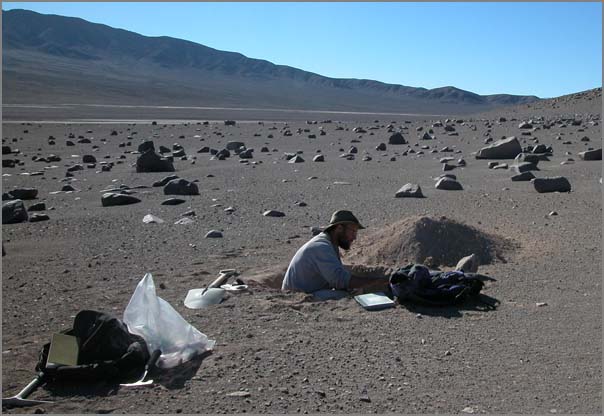
LOS ANGELES - Bizarre microbes flourish in the most punishing environments on Earth from the bone-dry Atacama Desert in Chile to the boiling hot springs of Yellowstone National Park to the sunless sea bottom vents in the Pacific. . Could such exotic life emerge in the frigid arctic plains of Mars? . NASA's Phoenix spacecraft could soon find out. Since plopping down near the Martian north pole a month ago, the three-legged lander has been busy poking its long arm into the sticky soil and collecting scoopfuls to bake in a test oven and peer at under a microscope. ...The article uses a photo from this 2004 NSF press release: Discovery Of Microbes and Mars, Desert microbe discovery has extraterrestrial implications

The driest parts of Chile's Atacama desert get rain once every few decades, yet microbial life exists a mere 8 to 12 inches below the parched terrain. Researcher Jay Quade, shown here in a test pit, samples the Mars-like landscape for soil carbonates. Credit: Julio L. Betancourt, U.S. Geological Survey.The article:
In truth, the similarities between the Atacama and Mars are striking. The surface of Mars has apparently been dry for millions or even billions of years. But the driest "absolute desert" region of the Atacama is not much moister; it rains there maybe once every other decade, though nobody bothers to measure it. In fact, the desiccated vista of dirt and rocks is so Mars-like that NASA uses the area as a model for the Red Planet. . Yet despite its inhospitable qualities, a team of Arizona scientists has discovered microbial life about a foot below the rough terrain. "We found life, we can culture it, and we can extract and look at its DNA," said Raina Maier, an environmental microbiologist at the University of Arizona in Tuscon and co-author of the work. . This finding, published as a letter in the November 19, 2004 issue of the journal Science, contradicts a previous report asserting that the Atacama's absolute desert is too dry to support life and is essentially sterile. ...The Atacama desert is pretty wild, but I have only been there through the cameras of the CMU/NASA Nomad rover in 2007. That was a fun project where I found the the first fossil found remotely with a rover while sitting in the back of the room paging through images.
06.22.2008 17:34
Phoenix - Mars weather report
Martian
Weather Report
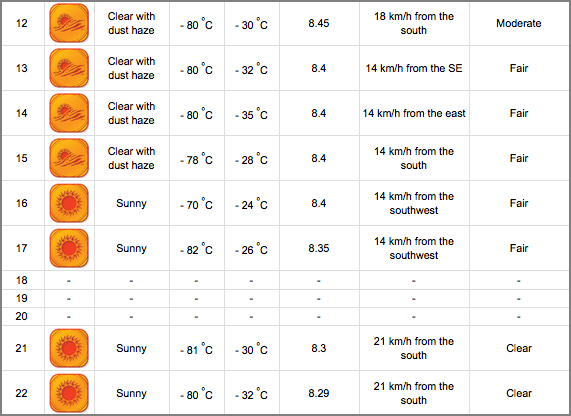
The Mars weather reports are updated regularly as soon as data is downloaded from the Phoenix Mars Lander. Due to technical considerations, the reports may not be available on a daily basis.

06.22.2008 09:47
Parsing AIS NMEA strings with Python regular expressions
I've been meaning to push my skills
with python regular expressions (regex) for a while and parsing AIS
USCG NMEA strings looked like a good way to practice. I've created
a 'verbose' regex that saves each of the fields such that they can
be easily accessed. The kodos regex tool made this a lot easier to
accomplish. Here is the sample code I ended up with:
Kodos has a help page and I also used the Regular Expression HOWTO. I don't have time to totally explain the above, so it is left to the reader as an excercise to walk through the regex.
#!/usr/bin/env python
import re
#
rawstr = r"""^[!$](?P<prefix>AI)(?P<stringType>VD[MO])
,(?P<total>\d?)
,(?P<senNum>\d?)
,(?P<seqId>[0-9]?)
,(?P<chan>[AB])
,(?P<body>[a-zA-Z0-9<>\?\'\`]*)
,(?P<fillBits>\d)\*(?P<checksum>[0-9A-F][0-9A-F])
(
(S(?P<slot>\d*))?
| (,s(?P<s>\d*))?
| (,d(?P<signal_strength>[-0-9]*))?
| (,T(?P<time_of_arrival>[0-9.]*))?
| (,x(?P<x>[0-9]*))
| (,(?P<station>(?P<station_type>[rb])[a-zA-Z0-9]*))?
)*
,(?P<timeStamp>\d+)
$"""
#
matchstr = """!AIVDM,3,4,,A,14hv0F8000Jrht<H?9Oaw2f`00Rn,0*44,s27706,d-102,T43.56976333,x155601,r003669945,1214092819"""
#
compile_obj = re.compile(rawstr, re.VERBOSE)
match_obj = compile_obj.search(matchstr)
#
print ' prefix = ', match_obj.group('prefix')
print ' stringType = ', match_obj.group('stringType')
print ' total = ', match_obj.group('total')
print ' senNum = ', match_obj.group('senNum')
print ' seqId = ', match_obj.group('seqId')
print ' chan = ', match_obj.group('chan')
print ' body = ', match_obj.group('body')
print ' fillBits = ', match_obj.group('fillBits')
print ' checksum = ', match_obj.group('checksum')
print ' slot = ', match_obj.group('slot')
print ' s = ', match_obj.group('s')
print 'signal_strength = ', match_obj.group('signal_strength')
print 'time_of_arrival = ', match_obj.group('time_of_arrival')
print ' x = ', match_obj.group('x')
print ' station = ', match_obj.group('station')
print ' station_type = ', match_obj.group('station_type')
print ' timeStamp = ', match_obj.group('timeStamp')
There are a few fields that can use better representations, but
this is a good start. Here is a sample run:
% ./retest.py
prefix = AI
stringType = VDM
total = 3
senNum = 4
seqId =
chan = A
body = 14hv0F8000Jrht<H?9Oaw2f`00Rn
fillBits = 0
checksum = 44
slot = None
s = 27706
signal_strength = -102
time_of_arrival = 43.56976333
x = 155601
station = r003669945
station_type = r
timeStamp = 1214092819
That's a pretty hard to read block of regular expressions, but it
already works lot better than the code I have in noaadata, which is
getting very painful.Kodos has a help page and I also used the Regular Expression HOWTO. I don't have time to totally explain the above, so it is left to the reader as an excercise to walk through the regex.
06.21.2008 16:15
More phx news releases
Ice
on Mars by Ned Potter [abc news]
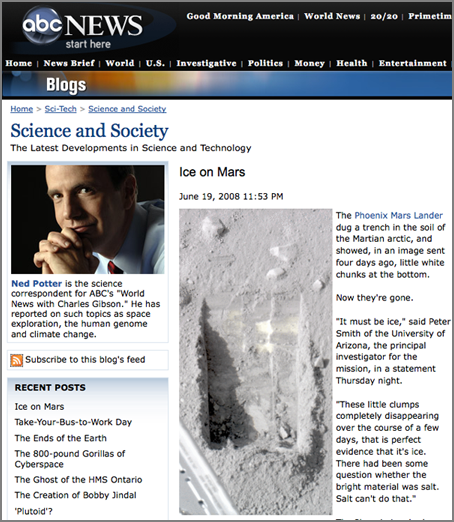
And it references the phoenix twitter site. Finally I am subscribed to marsphoenix

And it references the phoenix twitter site. Finally I am subscribed to marsphoenix
06.21.2008 09:35
Phx links and such
Scientists believe Mars lander exposed ice crumbs
[boston.com/AP]
Phoenix Mosaic - Aviation Week Cover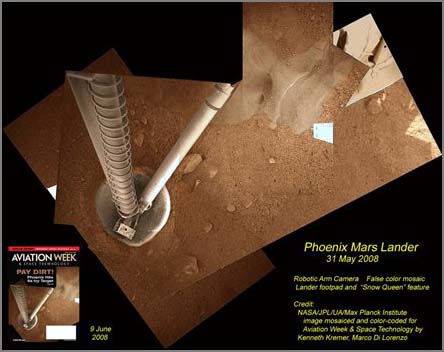
Joel H.'s shadow removal makes Aviation Week: Phoenix Lander Confirms Martian Water Ice
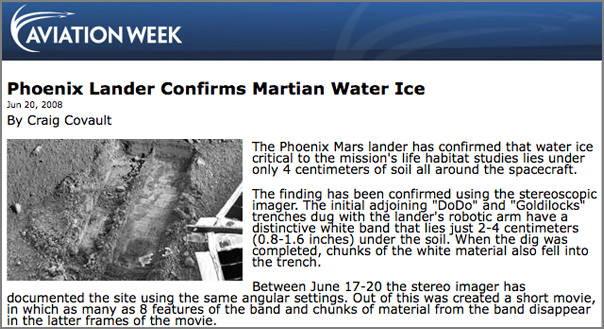
Phoenix Press Conference Update: Proof of Water Ice [universe today]
I lightened this image of the scoop material with photoshop. Astronomy Picture of the Day - 2008 June 8
Phoenix Mosaic - Aviation Week Cover
The cover of the June 9, 2008 Aviation Week & Space Technology features a mosaic of the area around one foot of the Phoenix Mars lander. Dr. Ken Kremer, one of the figures who prepared the mosaic for the magazine, kindly provided us with this close-up of the image. The caption that appears in AW&ST follows:The Phoenix Mars lander footpad to the left of an apparent large block of water ice, which was cleared of topsoil by descent rockets, indicates the spacecraft literally touched down on top of the primary sampling objective of the mission near the Martian North Pole on May 25. A wider version, with more elements of the false-color mosaic, is above...

Joel H.'s shadow removal makes Aviation Week: Phoenix Lander Confirms Martian Water Ice

Phoenix Press Conference Update: Proof of Water Ice [universe today]
I lightened this image of the scoop material with photoshop. Astronomy Picture of the Day - 2008 June 8
What surprises are hidden in the soils of Mars? To help find out, the Phoenix Lander Phoenix Lander which arrived on Mars two weeks ago has attempted to place a scoop of soil in Phoenix's Thermal and Evolved-Gas Analyzer (TEGA). Pictured above, the dirt-filled scoop approaches one of TEGA's eight ovens. Once in the oven, a soil material will be baked and the emitted gasses categorized by a mass spectrometer. Quite possibly, some of the light colored material visible in the scoop has the same composition as the light material imaged near the foot of the Lander, which may be ice. Phoenix is scheduled to spend the next three months digging, baking and chemically analyzing its immediate surroundings to better understand Mars and whether the boundary between ice and soil was ever capable of supporting life.
06.20.2008 17:32
more on phx ice
Answering
Mars Phoenix Commenters: E.g. "How Do You Know It's Not CO2
Ice?" [wired science]
Yep, it's ice! by Emily Lakdawalla [planetary society blog]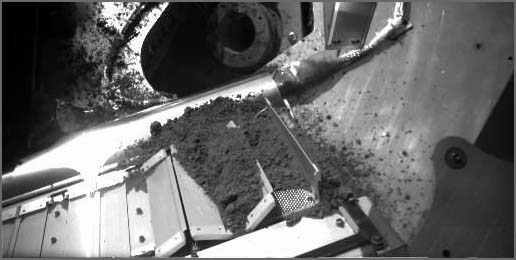
... How do you know it's not CO2 ice? . There is a lot of CO2 ice on Mars in the winter. However Phoenix landed in the Martian arctic during the summer (because it is solar powered). In the Martian summer it is much too hot for dry ice to be solid. It would be like trying to keep water ice from melting on a 140 degree day here on Earth. . Carbon dioxide (CO2) will freeze on Mars at -125 C. Today's weather report from the Canadian weather station on Phoenix shows a low of -80 C -- way too hot for dry ice to stay solid right now. (Note the largest "pebbles" were seen to stay solid for a day before disappearing). . Why not send instruments to detect life? . If you are going to make a claim like, "I have found life on Mars," you have to be prepared to show that there is NO chance your sample was contaminated with Earth bacteria before launch. To do that takes an incredible amount of sterilization (don't worry they are already doing a TON of sterilizing). But to REALLY be sure they would have to go to extreme measures to be able to rule out any contamination, doing that would drastically increase the cost of the mission beyond the budget the scientists have access to. So they make missions that look for water and the conditions of life etc with the budgets they have now. ...
Yep, it's ice! by Emily Lakdawalla [planetary society blog]
The Phoenix mission confirmed it this morning: the disappearing act pulled by those chunks of bright material in the Dodo trench pretty much nails the identification of the bright material as ice, which is great news for the mission. Ice is what Phoenix went all the way to Mars to study; it's what the team has been aiming for all these years. They expected to find it, but all this time, doubters and worriers (myself among them) have been asking, privately and publicly, what happens if they get there and can't reach ice? Well, that worry, it seems, has been dismissed. "This is final proof to our science team that we are looking at ice, and not some other substance," Peter Smith said in a teleconference today. Mark Lemmon said "I can verify from imaging data that we've found exactly what we went to Mars to look for. We can reach out and touch the ice on Mars now." ...And she noticed the Tega door 5...
Attempt to open TEGA door 5 Two images were taken of the TEGA instrument on sol 25, before and after an attempt to open the doors of oven number 5, adjacent to oven number 4, which had been opened previously and used for the first sample. The left-hand door of oven 4 never opened properly. It now appears that neither door on oven 5 has opened properly. ...

06.20.2008 17:24
The "Great Filter" - Drakes equation
Alex pointed me to this article:
Where Are
They? Why I hope the search for extraterrestrial life finds
nothing. By Nick Bostrom [MIT Tech Review]. I have to think
about this one for a while.
... If we discovered some very simple life-forms on Mars, in its soil or under the ice at the polar caps, it would show that the Great Filter must come somewhere after that period in evolution. This would be disturbing, but we might still hope that the Great Filter was located in our past. If we discovered a more advanced life-form, such as some kind of multicellular organism, that would eliminate a much larger set of evolutionary transitions from consideration as the Great Filter. The effect would be to shift the probability more strongly against the hypothesis that the Great Filter is behind us. And if we discovered the fossils of some very complex life-form, such as a vertebrate-like creature, we would have to conclude that this hypothesis is very improbable indeed. It would be by far the worst news ever printed. ...
06.20.2008 12:33
Water ice on Mars
Proof! Water Ice Found on Mars [space.com]
Scientists said today they have "found proof" of water ice on Mars away from the polar ice caps, a discovery made by NASA's Phoenix Mars Lander. . The finding is a crucial first step toward learning whether the ground on Mars is hospitable, because all life as we know it requires water. Now scientists can get on with the business of studying the chemistry of Mars dirt in more detail. . When the probe took photos of a ditch it had dug four days before, scientists noticed that about eight small crumbs of a bright material had disappeared. They concluded those crumbs had been water ice buried under a thin layer of dirt that vaporized when Phoenix exposed them to the air. . "It's with great pride and a lot of joy I announce today we have found proof that this hard material really is water ice and not some other substance," Phoenix principal investigator Peter Smith of the University of Arizona, Tucson said at a briefing Friday. ...
06.19.2008 21:02
Location and shadow removed trench
As a part of today's release Joel did
another shadow removal.
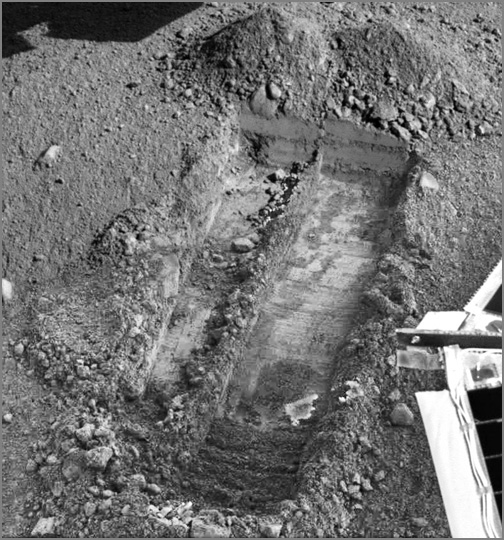
I incorporated his previous shadow removal into a location figure. This is a tough team to keep up with. Always so much going on!
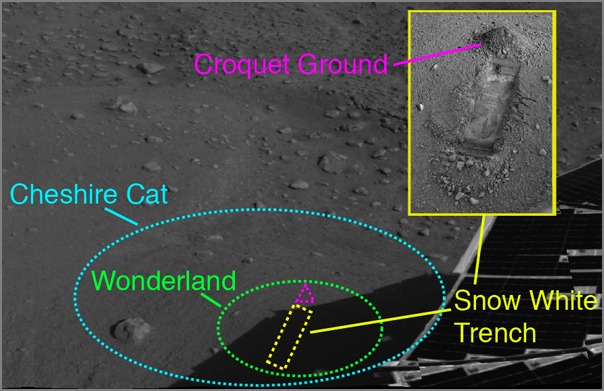

I incorporated his previous shadow removal into a location figure. This is a tough team to keep up with. Always so much going on!

06.19.2008 10:55
Phx flash issue
Mars Probe Loses Some Data in Memory Glitch [space.com]
NASA's Phoenix Mars Lander has lost some science observations in an odd glitch after generating too much housekeeping data, mission managers said Wednesday. . Phoenix engineers are investigating why the anomaly, which affected only unessential science data, occurred. It shouldn't be a problem today, they added, because they've planned activities for Phoenix that do not require the probe to store science data overnight. . "The spacecraft is healthy and fully commandable, but we are proceeding cautiously until we understand the root cause of this event," said Phoenix project manager Barry Goldstein of NASA's Jet Propulsion Laboratory. ...
06.18.2008 19:46
noaadata 0.39 released
noaadata 0.39 is out... The package is starting to get a number
of users that have been reporting bugs as they find them. I think
this puts it at about 6 people who have giving bug reports. Many
thanks to all of them. I think this version is back to working.
- ais.nmea module gone. bbm.py moved to scraps for now. This was causing major bugs.
- ais-port-forward now might actually work. Exception reporting more better
- new file: scraps/tideconvert.py for the tide3 station data processing
- new file: timetest.py
- ais_normalize.py can now treat A and B AIS channels as the same for USCG feed (-t)
- ais_normalize.py removed the stripDecimalTime option code
- ais_normalize.py - better station handling
06.18.2008 18:33
Hardware acceleration for XML networking?
Um, this is weird. If XML is the
bottle neck, what not use a different encoding. Hardware for XML
routing seems strange. But it should work, but yikes. How about a
binary flexible format like XML that is packed tighter, is designed
to make routing fast, and has a 1-to-1 mapping to XML? I spent a
lot of time with RTI's NDDS 2.x (now
DDS) and it was my first big networking middleware system that I
used, so my brain is wired differently I guess.
Tibco and Hardware Acceleration [magmasystems blog]
... Tibco was really paying attention to the shots fired across its bow by companies like RTI, 29West, and Tervela. Because of this, Tibco would try to breathe some new life into [Rendezvous (RV)], after spending so much focus on EMS. . Hardware-based routing of XML packets would seem to fit in well with Morgan Stanley's CPS message bus. It would also fit in well with CEP engines that like to deal with XML, such as Coral8. Imagine a hardware-based XML-to-Coral8-Tuple processor. ...
06.18.2008 17:59
Phx flash memory
NASA Mars Lander To
Dig; Team Probes Flash Memory
June 18, 2008 -- NASA's Phoenix Mars Mission generated an unusually high volume of spacecraft housekeeping data on Tuesday causing the loss of some non-critical science data. Phoenix engineers are analyzing why this anomaly occurred. The science team is planning spacecraft activities for Thursday that will not rely on Phoenix storing science data overnight but will make use of multiple communication relays to gain extra data quantity. . "The spacecraft is healthy and fully commandable, but we are proceeding cautiously until we understand the root cause of this event," said Phoenix Project Manager Barry Goldstein of NASA's Jet Propulsion Laboratory. . Usually Phoenix generates a small amount of data daily about maintaining its computer files, and this data gets a high priority in what gets stored in the spacecraft's non-volatile flash memory. On Tuesday, the quantity of this data was so high that it prevented science data from being stored in flash memory, so the remaining science data onboard Wednesday, when the spacecraft powered down for the Martian night after completing its 22nd Martian day, or sol, since landing, was not retained. None of that science data was high-priority data. Almost all was imaging that can be retaken, with the exception of images taken of a surface that Phoenix's arm dug into after the images were taken. . To avoid stressing Phoenix's capacity for storing data in flash memory while powered off for overnight sleeps, the team commanded Phoenix Tuesday evening to refrain from any new science investigations on Wednesday and to lower the priority for the type of file-housekeeping data that exceeded expected volume on Tuesday. . "We can continue doing science that does not rely on non-volatile memory," Goldstein said. Most science data collected during the mission has been downlinked to Earth on the same sol it has been collected, not requiring overnight storage, but on some sols the team has intentionally included imaging that yields more data than can fit in the afternoon communication passes. This has been done in order to take advantage of the capacity to downlink additional data during communications passes on the following Martian mornings. In the short term, while the root cause of the unexpected amount of housekeeping data is being determined, the science team will forgo that strategy of storing data overnight. . Meanwhile, extra communication-relay opportunities have been added to Thursday's schedule, so the science plan for the day will be able to generate plentiful data without needing overnight storage. Trench-digging, imaging and weather monitoring are in the plan.
06.17.2008 14:26
Sweet! Object-Oriented COBOL
Make the switch to object-oriented
COBOL programming more quickly and easily than you ever thought
possible. Standard
Object-Oriented Cobol
To get the power and benefit of COBOL's hot new object-oriented features and syntax, you'll have to learn a fresh approach to design. This fresh approach is exactly what this book gives you. Ned Chapin begins with a review of the traditional design approach. Then, building on what you already know about using COBOL, he guides you step-by-step across the great divide separating traditional design and modern design for object-oriented COBOL. He demonstrates how the same jobs can be tackled using the new standard object-oriented COBOL. He also shows how to combine using object-oriented and traditional COBOL.Funny how I never even saw COBOL in school or since.
06.17.2008 11:22
STP and Viz show off the trench
The stereopipeline (STP) made a nice
model of the Dodo-Goldilocks trench shown here in Viz:
PIA10904 [JPL Planetary Photojournal]
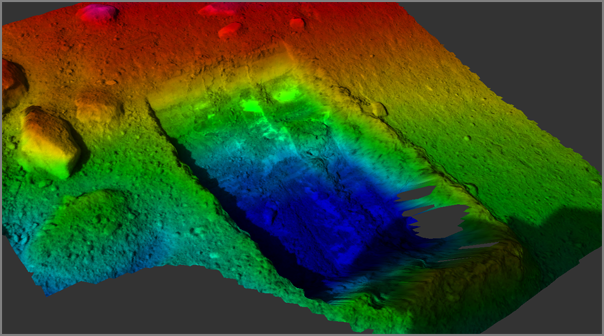
PIA10904 [JPL Planetary Photojournal]

06.17.2008 10:47
Reducing the impact of shadows
Steve showed me that Photoshop CS3
has a tool for weaking shadows.
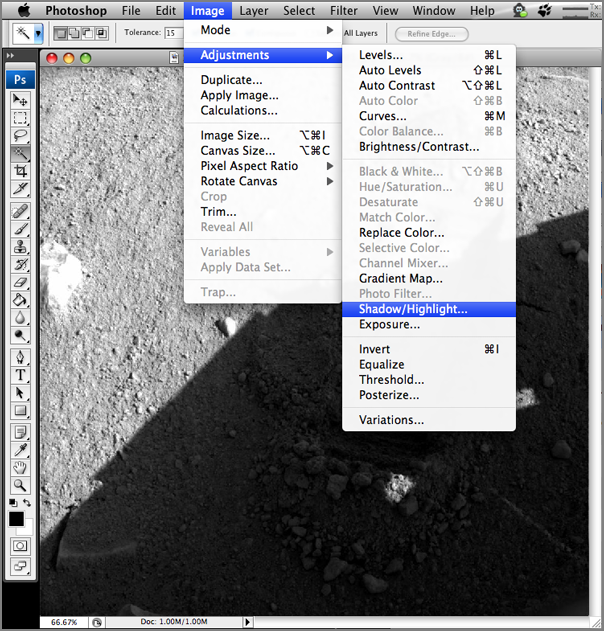
Here is an example of turning the knobs:
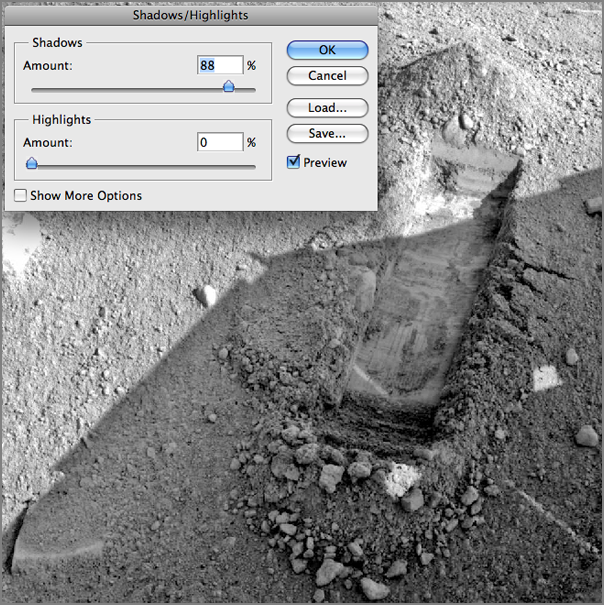
Photoshop pros will have better ways of handling this process, but the shadow adjustment will give quick results. We have a pro on staff to do the really hard ones. jhagen's handy work that was just released as today's press image:
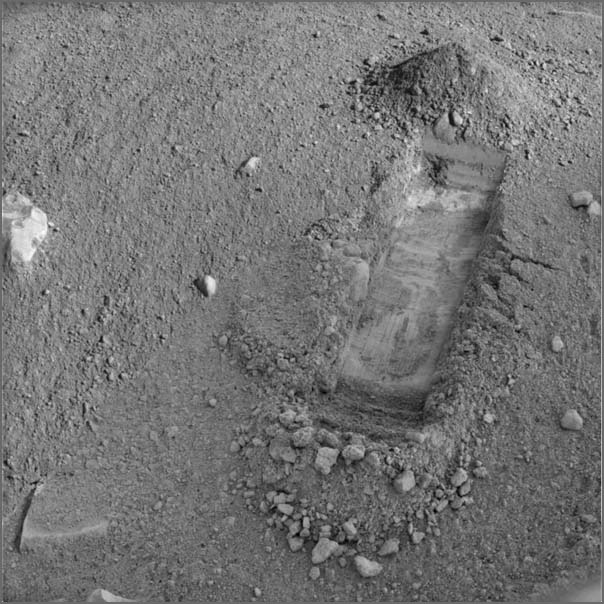

Here is an example of turning the knobs:

Photoshop pros will have better ways of handling this process, but the shadow adjustment will give quick results. We have a pro on staff to do the really hard ones. jhagen's handy work that was just released as today's press image:

06.17.2008 10:06
AP Mars update
Mars team ponders whether lander sees ice or salt [boston.com]
Is the white stuff in the Martian soil ice or salt? . That's the question bedeviling scientists in the three weeks since the Phoenix lander began digging into Mars' north pole region to study whether the arctic could be habitable. . Shallow trenches excavated by the lander's backhoe-like robotic arm have turned up specks and at times even stripes of mysterious white material mixed in with the clumpy, reddish dirt. ...
06.16.2008 13:00
JGR article on the Phoenix Robot Arm
Bonitz, Shiraishi, Robinson,
Arvidson, Chu, Wilson, Davis, Paulsen, Kusack, Archer, Smith,
"NASA Mars 2007 Phoenix Lander Robotic Arm and Icy Soil
Acquisition Device", JOURNAL OF GEOPHYSICAL RESEARCH, VOL.
113, E00A01, doi:10.1029/2007JE003030, 2008.
Article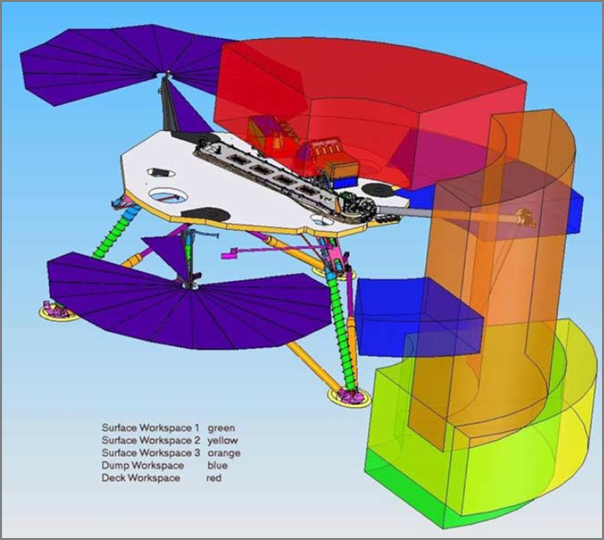
Article
Abstract The primary purpose of the Mars 2007 Phoenix Lander Robotic Arm (RA) and associated Icy Soil Acquisition Device (ISAD) is to acquire samples of Martian dry and icy soil (DIS) by digging, scraping, and rasping, and delivering them to the Thermal Evolved Gas Analyzer and the Microscopy, Electrochemistry, and Conductivity Analyzer. The RA will also position (1) the Thermal and Electrical Conductivity Probe (TECP) in the DIS; (2) the TECP at various heights above the surface for relative humidity measurements, and (3) the Robotic Arm Camera to take images of the surface, trench, DIS samples within the ISAD scoop, magnetic targets, and other objects of scientific interest within its workspace. The RA/ISAD will also be used to generate DIS piles for monitoring; conduct DIS scraping, penetration, rasping, and chopping experiments; perform compaction tests; and conduct trench cave-in experiments. Data from the soil mechanics experiments will yield information on Martian DIS properties such as angle of repose, cohesion, bearing strength, and grain size distribution.

06.16.2008 11:34
Mars in InfoWeek
The sample contains almost 1,000 separate particles -- some smaller
than 1/10 the diameter of a human hair. [imformation week]
... "This is the first time since the Viking missions three decades ago that a sample is being studied inside an instrument on Mars," Phoenix Principal Investigator Peter Smith from the University of Arizona, Tucson, said in a news announcement. "Understanding the soil is a major goal of this mission and the soil is a bit different than we expected. There could be real discoveries to come as we analyze this soil with our various instruments. We have just the right instruments for the job." . The sample contains almost 1,000 separate particles -- some smaller than 1/10 the diameter of a human hair, NASA reported. The soil contains larger, shiny, black specs and smaller reddish particles and scientists said they have found at least four minerals in the sample. NASA said the particles look like those found in airborne dust. . "We may be looking at a history of the soil," Tom Pike, of Imperial College London and Phoenix co-investigator, said. ...
06.16.2008 07:38
Portsmouth, NH underwater security system
Haven't ever talked to these people
at all and only know of this through the news paper articles. I
don't know of any discussions with UNH about this project.
FEMA to inspect city's underwater security system [seacoastonline]
FEMA to inspect city's underwater security system [seacoastonline]
... A federal grant in the amount of $1.18 million is paying for the project. Pease Development Authority Finance Director Irv Canner said about $990,000 of that money has already been spent. ... The system was developed by Sonatech Corp. of Bedford ... Sonar detectors are being placed on either side of the Sarah Long Bridge and in other locations to scan near the Interstate 95 bridge and Memorial Bridge. ... Woodsum said terrorists are close to having the ability to use divers to attach bombs to ship hulls and bridges ...I think this is the company: sonatech.
06.15.2008 18:22
Timestamping and UTC
When properly using timestamps in
python, you can indeed get UTC time. No fancy conversions needed.
All that is need is for NTP to actually be working (doh!)
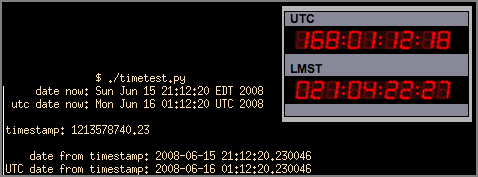
#!/usr/bin/env python
#
import time
import datetime
import os
import sys
#
print ' date now: ',
sys.stdout.flush()
os.system ('date')
#
print 'utc date now: ',
sys.stdout.flush()
os.system ('date -u')
sys.stdout.flush()
#
now = time.time()
#
print
print 'timestamp:', now
print
#
print ' date from timestamp:',datetime.datetime.fromtimestamp(now)
print 'UTC date from timestamp:',datetime.datetime.utcfromtimestamp(now)
Here is a run of the script plus the screen capture from a flight
tool that shows UTC. It took me and the computer just over a second
to get from running the command to doing the screen grab. 
06.15.2008 15:28
Audiophiles are crazy
Alex just pointed me at this... it's
a 1.5 m ethernet cable for $500. Are there really suckers
out there who pay for this? Data is data and the protocol over the
wire is running error correction, so you will get the same
exact data sent with a plain old Cat-6 cable for a couple
dollars.
AK-DL1: Ultra Premium Denon Link Cable [denon] with "woven jacketing to reduce vibration". Huh? We use standard ethernet cables in robots going off road. And... "Additionally, signal directional markings are provided for optimum signal transfer." They are kidding, right?
Are BER (bit error rate) really that high that normal cables don't give 100% perfect transmission with FEC (forward error correction)? Maybe if you are putting your stereo right in front of an FAA radar station. Someone please correct me if I'm wrong. Is this just trying to reduce the number of corrupt ethernet packets? And what protocol are these devices using?

AK-DL1: Ultra Premium Denon Link Cable [denon] with "woven jacketing to reduce vibration". Huh? We use standard ethernet cables in robots going off road. And... "Additionally, signal directional markings are provided for optimum signal transfer." They are kidding, right?
Are BER (bit error rate) really that high that normal cables don't give 100% perfect transmission with FEC (forward error correction)? Maybe if you are putting your stereo right in front of an FAA radar station. Someone please correct me if I'm wrong. Is this just trying to reduce the number of corrupt ethernet packets? And what protocol are these devices using?

06.13.2008 20:35
Phoenix Microscope Animation - Google Video
youtube seemed unable to get these
videos. I went for Google Video and it worked. I've never done
google video before. The quality is drastically reduced.
google video link
13xxx_MECA_schematic_sol_19_h264.mov [phoenix.lpl]
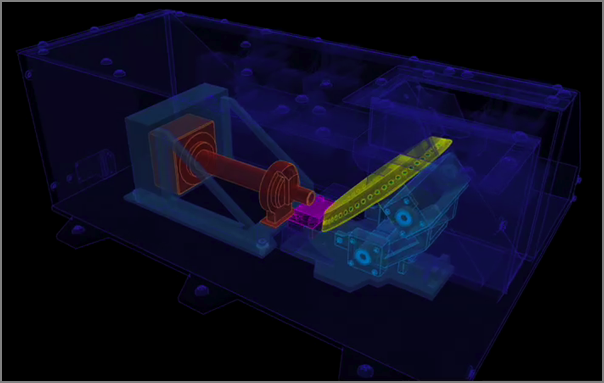
google video link
13xxx_MECA_schematic_sol_19_h264.mov [phoenix.lpl]

06.13.2008 16:51
Making an animated gif into a HD movie
I need to be able to convert animated
gifs into HD movies. It is possible to using Quicktime Pro if you
have Final Cut Pro (FCP) installed on the machine. If you do, you
will have these components on the Mac:

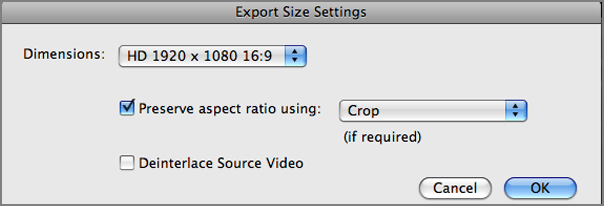
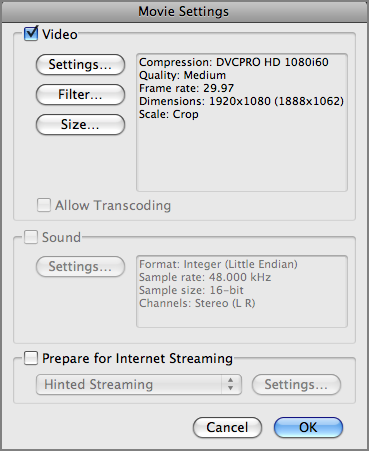
% ls /Library/QuickTime/ | grep DVC DVCPROHDCodec.component DVCPROHDMuxer.component DVCPROHDVideoDigitizer.component DVCPROHDVideoOutput.component DVCPROHDVideoOutputClock.component DVCPROHDVideoOutputCodec.componentThen here are the steps. Drop the animated gif on the Quicktime icon. File -> Export.



06.13.2008 16:24
Last week's phoenix press conference
Here are two pictures of me working
last week's Phoenix press conference. I ran the still and animation
feed.
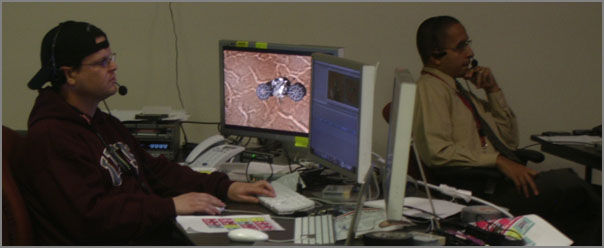
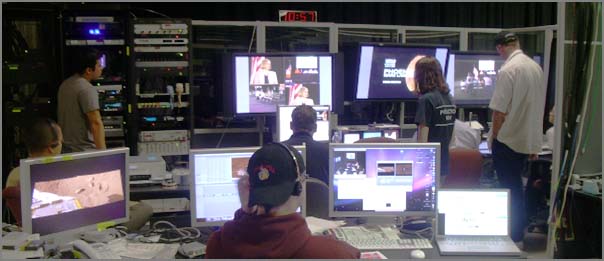


06.12.2008 07:37
Art and AUV v1
Old news discovered by Christiana:
Titanic Explorer to Search for Shipwrecks in the Black Sea
[shipwreckcentral] Aug 2007.
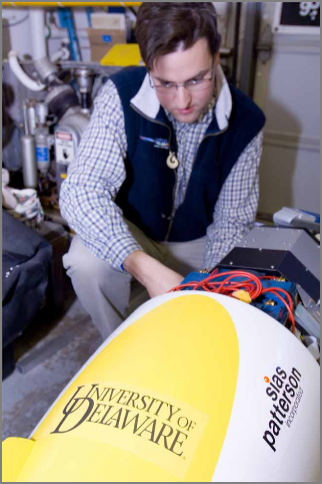
... Expedition member Art Trembanis, a marine scientist at the University of Delaware, said the team will use DOERRI to return to a Byzantine-era shipwreck in the Black Sea that Ballard and his team located last year and to search for other wrecks. "We hope DOERRI ... will allow us to discover very ancient shipwrecks, previously unknown, on the Black Sea floor," Trembanis said. "Along the way, DOERRI will also give us new insights into the dynamics ... that help to shape and mold the seafloor." ...

06.11.2008 14:16
TEGA oven 4 full of dirt!
NASA's Phoenix Lander
Has An Oven Full Of Martian Soil
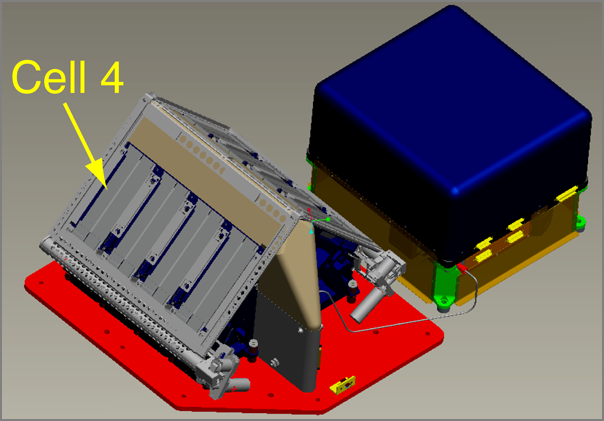
June 11, 2008 -- NASA's Phoenix Mars Lander has filled its first oven with Martian soil. . "We have an oven full," Phoenix co-investigator Bill Boynton of the University of Arizona, Tucson, said today. "It took 10 seconds to fill the oven. The ground moved." . Boynton leads the Thermal and Evolved-Gas Analyzer instrument, or TEGA, for Phoenix. The instrument has eight separate tiny ovens to bake and sniff the soil to assess its volatile ingredients, such as water. . The lander's Robotic Arm delivered a partial scoopful of clumpy soil from a trench informally called "Baby Bear" to the number 4 oven on TEGA last Friday, June 6, which was 12 days after landing. . A screen covers each of TEGA's eight ovens. The screen is to prevent larger bits of soil from clogging the narrow port to each oven so that fine particles fill the oven cavity, which is no wider than a pencil lead. Each TEGA chute also has a whirligig mechanism that vibrates the screen to help shake small particles through. . Only a few particles got through when the screen on oven number 4 was vibrated on June 6, 8 and 9. . Boynton said that the oven might have filled because of the cumulative effects of all the vibrating, or because of changes in the soil's cohesiveness as it sat for days on the top of the screen. . "There's something very unusual about this soil, from a place on Mars we've never been before," said Phoenix Principal Investigator Peter Smith of the University of Arizona. "We're interested in learning what sort of chemical and mineral activity has caused the particles to clump and stick together." . Plans prepared by the Phoenix team for the lander's activities on Thursday, June 12 include sprinkling Martian soil on the delivery port for the spacecraft's Optical Microscope and taking additional portions of a high-resolution color panorama of the lander's surroundings.

06.11.2008 09:31
IM'ing good for work
Please pass this along to the people
at NOAA that block instant messanger for NOAA staff. I've been
using IM with colleagues on Phoenix with great success and find
that I get more done with those who IM and have a harder time
working with those that do not IM. Especially during big meetings
and teleconferences, I can get work done and coordinate tasks
without interupting the group discussion.
Study Finds Instant Messaging Helps Productivity
Study Finds Instant Messaging Helps Productivity
The results of a recently published study of workers' instant messaging (IM) use shows that IM can actually improve workplace productivity. This contradicts a widely held belief that IM in the workplace is a hindrance to productivity. IM is often perceived as an interruption, and as such, "it can significantly hinder productivity by disrupting thought processes and work flows, causing individuals to take longer to complete tasks." . Researchers at Ohio State University and the University of California, Irvine conducted a telephone study by randomly surveying individuals employed full-time who use computers in an office environment at least five hours per week. They netted 912 respondents, of which 29.8 percent claimed to use IM in the workplace "to keep connected with coworkers and clients." Interestingly, the demographics of the IM users were essentially identical to that of the non-IM users in the study, with a mean age of 43.7 years old and 53.2 percent female. Neither occupation, education, gender, nor age seem to have an impact on whether an individual is an IM user or not. This should throw out a few more generally accepted beliefs that IM users are predominately tech-savvy young men. ...
06.11.2008 09:26
More Frontier Sentinel articles
Mock attack targets: tanker, tugboats, bridge By Karen
Dandurant [seacoastonline.com]
Terror drill: 'we are one team, one fight' [seacoastonline]
U. S., Canadian forces hold terrorist drill in Portsmouth, Kittery waters [fosters.com]
... Here is the scenario as told by Chief John Roberts of Coast Guard Station Portsmouth Harbor: . "At 8:54 a.m., we received a call telling us we just looked out of the control tower window and saw an explosion on a 600-foot tanker," Roberts said. "There was no boat, of course, but we launched one asset to determine what had happened. We learned it was an explosion on the stern. We also got a report that a local area tugboat operator was missing and his tug was gone. Another mariner pulled the operator out of the water, alive, at 9:07 a.m. He said three men had hijacked his tug." . At 9:35 a.m., the Coast Guard was notified of a fire on a tugboat at the Port Authority. Portsmouth Fire Department took command and dealt with the fire while the New Hampshire Marine Patrol provided security. . "At 10:02 a.m., we were told that there was a vessel pinned against the Sarah Long Bridge," Roberts said. "It was disabled and the current was keeping it at the bridge." ...
Terror drill: 'we are one team, one fight' [seacoastonline]
U. S., Canadian forces hold terrorist drill in Portsmouth, Kittery waters [fosters.com]
... With divers swarming about the busy currents of the Piscataqua and ships strewn throughout the waterway, exercise "Frontier Sentinel" officially kicked into full gear. Members of the media were invited to get a behind-the-scenes look at the training operation. ...
06.10.2008 18:39
Adding a stack trace to an error report in python
For some code that I have that parses
AIS code, I want to know about any errors, but I really want to
code to keep going. I wrapped the whole processing of one in a try,
but that just hid what was going wrong for some lines. There are
occasional bad lines in the data. I added two lines to end of the
basic
exception example in the python documentation:
#!/usr/bin/env python
import sys, traceback
try:
raise Exception('spam', 'eggs')
except Exception, inst:
print type(inst) # the exception instance
print inst.args # arguments stored in .args
print inst # __str__ allows args to printed directly
x, y = inst # __getitem__ allows args to be unpacked directly
print 'x =', x
print 'y =', y
# Now write to stderr, where errors should go
sys.stderr.write(str(type(inst))+'\n')
sys.stderr.write( str(inst)+'\n')
traceback.print_exc(file=sys.stderr)
The results now look like:
% ./ex_test.py
<type 'exceptions.Exception'>
('spam', 'eggs')
('spam', 'eggs')
x = spam
y = eggs
<type 'exceptions.Exception'>
('spam', 'eggs')
Traceback (most recent call last):
File "./ex_test.py", line 4, in <module>
raise Exception('spam', 'eggs')
Exception: ('spam', 'eggs')
Now I can hopefully log and fix any problems that I run into. For
starters, I just ran into the 4GB limit on filesize. Now, I have to
process by month or change my code. My norm2008.bash script:
#!/bin/bash
for mon in 01 02 03 04 05 06 07 08 09 10 11 12; do
echo Starting month $mon
~/projects/src/noaadata/scripts/ais_normalize.py -v -t -o 2008-${mon}.norm uscg-logs-2008-${mon}*
done
06.10.2008 17:13
Arctic Martian sun
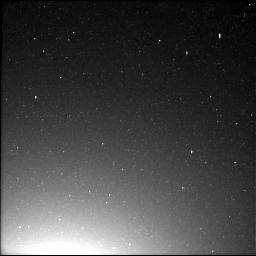
This image was acquired at the Phoenix landing site on day 16 of the mission on the surface of Mars, or Sol 15, after the May 25, 2008, landing. The surface stereo imager left acquired this image at 17:20:23 local solar time. The camera pointing was elevation 37.7223 degrees and azimuth 275.848This is unfortunately not a sunset. The dots are dark current on the CCD.
06.10.2008 14:20
Frontier Sentinel - finding mines and other issues
Update 6/15:
Terrorism drill deemed a success [seacoastonline]
Frontier Sentinel [youtube] video by SeaCoastOnline
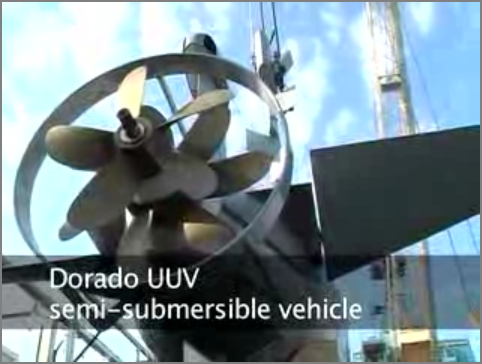
Seacoast drill features mines, explosion
Frontier Sentinel [youtube] video by SeaCoastOnline

Seacoast drill features mines, explosion
... The drill kicked off about 9 a.m. Monday with news of the shipboard explosion. The Coast Guard and Navy, with help from the FBI and local law enforcement, investigated. They pretended to close the port. . When they discovered that submerged mines may have been involved, Canada's Joint Task Force Atlantic stepped in with a seven-ton, remote-controlled mine detector. Called the Dorado, the device can be controlled from about three to five miles away. ...
06.10.2008 09:21
ZFS for Mac OSX
10.6 server
lists ZFS as a new feature, but 10.6 user does not!
I hope this is just marketing and that ZFS support is available for
both the desktop and server editions of Mac OSX 10.6 (snowleopard).
ZFS For business-critical server deployments, Snow Leopard Server adds read and write support for the high-performance, 128-bit ZFS file system, which includes advanced features such as storage pooling, data redundancy, automatic error correction, dynamic volume expansion, and snapshots.ZFS and better 64-bit support are my two main hopes for 10.6. Oh, and what about building the drivers for 3G wireless networks (e.g. Verizon EVDO). Verizon seems unable to write a decent driver for their card on their own. Maybe if apple stepped up, it would be better.
06.09.2008 21:14
NatureNews on Phoenix contamination
'Dandruff'
could contaminate Phoenix landing site
... "We will see organics, for sure, because we're bringing them," says Aaron Zent, a mission scientist from NASA's Ames Research Center in California. Likely contaminants include skin flakes, dead microbes and volatile lubricants. "The problem with an instrument so sensitive is all you detect is your own schmutz," says Zent. ...
06.09.2008 14:56
AIS messages split across channels?
This is really strange! I am seeing
AIS messages split across channels. Is this really going across the
VDL? Is this a receiver bug, logging bug, or something else? Maybe
shipdata message is being sent over both A and B channels and the
data logging system decides to keep one part from one and another
part from the other?
!AIVDM,2,1,8,A,55MtCG01ssMAM9?;W;@l58Ttr2220lu84p00000l18L,0*3C,s24576,d-112,r00370003,1167621101 !AIVDM,2,2,8,B,004@a0>k0H4Sk@CP@00000000000,2*38,s26987,d-107,r00370003,1167621101By hacking the checksum and forcing both to be the same channel, I created this normalized packaet and decoded it.
% ais_msg_5.py -d '!AIVDM,1,1,8,A,55MtCG01ssMAM9?;W;@l58Ttr2220lu84p00000l18L004@a0>k0H4Sk@CP@00000000000,2*06,s26987,d-107,r00370003,1167621101'
shipdata:
MessageID: 5
RepeatIndicator: 0
UserID: 366941020
AISversion: 0
IMOnumber: 8121812
callsign: WRS2924
name: MARION MORAN@@@@@
shipandcargo: 52
dimA: 9
dimB: 28
dimC: 0
dimD: 0
fixtype: 1
ETAminute: 4
ETAhour: 5
ETAday: 4
ETAmonth: 0
draught: 5.9
destination: LA ROMANA@@@@@@@@@@@
dte: 0
Spare: 0
I guess they go together, but how to tell? The next version of
ais_normalize.py has a -t option to treat A and B as one
channel.06.09.2008 13:55
SciAm says blogging is good for you
Blogging--It's
Good for You

Self-medication may be the reason the blogosphere has taken off. Scientists (and writers) have long known about the therapeutic benefits of writing about personal experiences, thoughts and feelings. But besides serving as a stress-coping mechanism, expressive writing produces many physiological benefits. Research shows that it improves memory and sleep, boosts immune cell activity and reduces viral load in AIDS patients, and even speeds healing after surgery. A study in the February issue of the Oncologist reports that cancer patients who engaged in expressive writing just before treatment felt markedly better, mentally and physically, as compared with patients who did not. ... At the University of Arizona, psychologist and neuroscientist Richard Lane hopes to make brain-imaging techniques more relevant by using those techniques to study the neuroanatomy of emotions and their expressions. ...I don't think they mean the kind of blog that I write

06.08.2008 15:37
printing EBCDIC SEGY seismic data headers
Update: Jenna Hill suggested a
simpler command.
dd if=file.sgy conv=ascii ibs=3200 count=1I didn't realize that dd knows how to convert from EBCDIC to ASCII:
conv=value[,value ...]
ascii
The same as the unblock value except that characters
are translated from EBCDIC to ASCII before the records
are converted. (These values imply unblock if the op-
erand cbs is also specified.)
Here is a bit of code that will print out the first 3200 character
text header of a seismic SEGY data file. It will notice if the text
is EBCDIC and convert it to ascii or you can force it to convert.
You can also ask it to split at 80 character line boundaries for
well formed text headers. Here is an example with a header that
seems to be missing some things.
% ./short.py --split-80 0001_2004_026_LF.sgy C 1 CLIENT COMPANY CREW NO C 2 LINE AREA MAP ID C 3 REEL NO DAY-START OF REEL YEAR OBSERVER C 4 INSTRUMENT: MFG KEL MODEL 320B/R SERIAL NO K99403 C 5 DATA TRACES/RECORD AUXILIARY TRACES/RECORD CDP FOLD C 6 SAMPLE INTERVAL SAMPLES/TRACE BITS/IN BYTES/SAMPLE C 7 RECORDING FORMAT FORMAT THIS REEL MEASUREMENT SYSTEM C 8 SAMPLE CODE: FLOATING PT FIXED PT X FIXED PT-GAIN CORRELATED C 9 GAIN TYPE: FIXED BINARY FLOATING POINT OTHER C10 FILTERS: ALIAS HZ NOTCH HZ BAND - HZ SLOPE - DB/OCT C11 SOURCE: TYPE NUMBER/POINT POINT INTERVAL C12 PATTERN: LENGTH WIDTH C13 SWEEP: START HZ END. HZ LENGTH MS CHANNEL NO TYPE C14 TAPER: START LENGTH MS END LENGTH MS TYPE C15 SPREAD: OFFSET MAX DISTANCE GROUP INTERVAL C16 GEOPHONES: PER GROUP SPACING FREQUENCY MFG MODEL C17 PATTERN: LENGTH WIDTH C18 TRACES SORTED BY: RECORD CDP OTHER C19 AMPLITUDE RECOVERY: NONE SPHERICAL DIV AGC OTHER C20 MAP PROJECTION ZONE ID COORDINATE UNITS C21 PROCESSING: C22 PROCESSING: C23 ... C39 C40 END EBCDICI should have used the python cp037.py for EBCDIC that comes with python, but here is the code:
#!/usr/bin/env python
__author__ = "Don Perterson did the a2e and e2a functions. Kurt Schwehr did the UI"
"""
Description: ASCII <=> EBCDIC conversion functions. The arrays were
taken from the Snippets collection.
"""
import sys
e2aG = [
0, 1, 2, 3,156, 9,134,127,151,141,142, 11, 12, 13, 14, 15,
16, 17, 18, 19,157,133, 8,135, 24, 25,146,143, 28, 29, 30, 31,
128,129,130,131,132, 10, 23, 27,136,137,138,139,140, 5, 6, 7,
144,145, 22,147,148,149,150, 4,152,153,154,155, 20, 21,158, 26,
32,160,161,162,163,164,165,166,167,168, 91, 46, 60, 40, 43, 33,
38,169,170,171,172,173,174,175,176,177, 93, 36, 42, 41, 59, 94,
45, 47,178,179,180,181,182,183,184,185,124, 44, 37, 95, 62, 63,
186,187,188,189,190,191,192,193,194, 96, 58, 35, 64, 39, 61, 34,
195, 97, 98, 99,100,101,102,103,104,105,196,197,198,199,200,201,
202,106,107,108,109,110,111,112,113,114,203,204,205,206,207,208,
209,126,115,116,117,118,119,120,121,122,210,211,212,213,214,215,
216,217,218,219,220,221,222,223,224,225,226,227,228,229,230,231,
123, 65, 66, 67, 68, 69, 70, 71, 72, 73,232,233,234,235,236,237,
125, 74, 75, 76, 77, 78, 79, 80, 81, 82,238,239,240,241,242,243,
92,159, 83, 84, 85, 86, 87, 88, 89, 90,244,245,246,247,248,249,
48, 49, 50, 51, 52, 53, 54, 55, 56, 57,250,251,252,253,254,255
]
#
def EbcdicToAscii(str):
if type(str) != type(""):
raise "Bad data", "Expected a string argument"
if len(str) == 0: return str
newstr = ""
for ix in xrange(len(str)):
newstr = newstr + chr(e2aG[ord(str[ix])])
return newstr
# This could be made faster
def printSplit80(s):
for i in range(len(s)):
if i%80==0 and i>0:
sys.stdout.write('\n'+s[i])
else:
sys.stdout.write(s[i])
#
if __name__ == '__main__':
from optparse import OptionParser
parser = OptionParser(usage="%prog [options] files")
parser.add_option('--force-ebcdic', dest='ebcdic', default=False
, action='store_true'
, help='Force treating the input files as EBCDIC')
parser.add_option('--split-80', dest='split80', default=False
, action='store_true'
, help='Split at 80 character boundaries for well formed header')
(options, args) = parser.parse_args()
#
for filename in args:
f = file(filename)
headerStr = f.read(3200)
if options.ebcdic or not headerStr[0].isalnum():
headerStr = EbcdicToAscii(headerStr)
if options.split80:
printSplit80(headerStr)
else:
print headerStr
06.06.2008 21:56
Phx on ComputerWorld
NASA: 'Extreme programming' controls Mars Lander robot Engineers
send code 170 million miles through space daily in search for life
on Mars
"Optech Lidar Technology Delivers Weather Reports from Mars"
Matthew Robinson, the robotic arm flight software engineer at the Jet Propulsion Laboratory, said the team has to write the code sequences to run different parts of the Phoenix spacecraft, including the robotic arm, the cameras and analysis equipment. One mistake and the Lander sits idle for a day, wasting precious time that could be used to discover if the planet can support life. . So far, all the code they've beamed up to Mars in the past week has worked. . "It's a challenge because we have a two- to three-day strategic plan, and then each day that plan is refined," Robinson told Computerworld. "They decide on the final plan that day. You have to build 20 to 30 sequences, and each can have 50 lines of code in it. And they have a lot of interplay between different instruments, so you have to make sure the sequences are not just working, but working together. . "Building the sequences is an extreme programming challenge every single day," he added. . And the developers, who used the C programming language to build their own software for a Linux operating system, are expected to be dealing with that challenge for about three months. ...and Monica points to an article about Lidar for Mars weather
"Optech Lidar Technology Delivers Weather Reports from Mars"
... The Phoenix lidar was designed and built by Optech in partnership with MDA Space Missions, with funding from the Canadian Space Agency. The analytical lidar, which probes the atmosphere above the lander, is the first of its kind to be sent to another world. The Phoenix mission is also the first of its kind, selected by NASA from an initial set of over 20 mission proposals, designed to land in the north polar region of Mars to study the atmosphere and look for habitability supporting life. ...
06.06.2008 10:18
Changing the brightness of the scoop
For today's press teleconference, the
RA scooped material was really dark. I used the Photoshop Magic
Wand with a Tolerance of 2 followed by Shift and more Magic Wand's
to get the main region. Then I used the Rectangular Marquee Tool to
get a bunch of center patches that didn't want to select. Then I
copied that region (Apple-C), created a new layer (Shift-Apple N),
and pasted the scoop material into a new layer (Apple-V). I then
used Image->Adjustments->->Curves (or Apple-M). I
flattened the image (Layer->Flatten Image) followed by a
File->Save As to give it a name with the original name plus
extra text to make it clear that the new image is not an original
Experiment Data Record (EDR). This process works well to bring out
darker regions of the image. The results are now up on the
web.
The original EDR: SS011EFF897193286_11BEEL1M1 [phoenix.lpl]
Soil Sample Poised at TEGA Door [phoenix.lpl]

The original EDR: SS011EFF897193286_11BEEL1M1 [phoenix.lpl]
Soil Sample Poised at TEGA Door [phoenix.lpl]

06.06.2008 06:09
New Hampshire's new boating rule
Laws aim to keep summer boaters safe [seacoastonline]
Dunleavy said this year is also the first year New Hampshire boaters are required to have passed a safe boating course. . "You need to keep your card with you," he said. . The Marine Patrol will ask to see all of the safety equipment required by law for your size vessel. If there is a deficiency, the Marine Patrol will tell you what is needed. If the boat is in compliance with all safety requirements, owners will be issued a courtesy inspection sticker. . "Power boats require a sound producing device - a horn, whistle or power horn, - and fire extinguishers," Dunleavy said. "If you have a fixed automatic system, we encourage also carrying a portable in case of an electrical fire under the dashboard. Plus, you can assist others. All powered vessels, including canoes, kayaks, the Thomas Laighton, speed boats, and any other types, are required to display lights. Manually propelled boats need one white light visible two miles in all directions. Once you attach a motor, or the boat is over 21 feet, you're required to display red and green lights visible up to a mile."
06.05.2008 12:22
Viz and similiar sized rocks
Here I am at the SOC standing in
front of a printout of the Viz terrain on the floor in front of the
spacecraft mockup. Two of the team have been working towards
recreating the rock distribution seen on Mars.
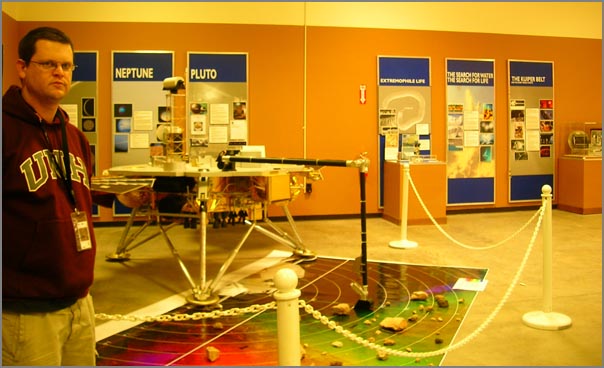

06.05.2008 12:07
Frontier Sentinel
Nothing really new in this report,
but the excercise starts Monday of next week. Canadian
and U.S. forces team up with Frontier Sentinel
Approximately 3,000 personnel from Canadian and U.S. military forces and government civilian agencies will participate in the full-scale training exercise Frontier Sentinel (EX FS 08-2), which will focus on maritime homeland security from June 9-13, 2008. ... The Frontier Sentinel exercise's objective is to practice, evaluate, and recommend improvements for multi-agency responses to maritime security threats with a focus on underwater mine detection and countermeasures. . Exercise planners chose this area because of the unique challenges it offers. The port is home to the Portsmouth Naval Shipyard and a host of key industrial facilities, many of which are vital to the New England energy infrastructure. . Capt. Jeff Carlson of the U.S. Navy's Mine and Anti-Sub warfare division also highlighted the need to forge a close partnership, stating that "our objective is the same as the Captain of the Port's, which is to determine the safest route in and out of the port as quickly as possible."
06.05.2008 12:03
Remote Desktop for 5 projector display
I just setup up 6 headed mac to run a
5 projector 60 ft display. Apple Remote Desktop is the key to
making this thing easy to run. I can sit in the audience and
control it. Screen 1 is not on the projectors such that I prep
material and then throw it onto the other 5. Each projector is
1280x1024. This works pretty well.


06.04.2008 18:22
Comm troubles with ODY
Communications glitch delays Mars lander digging [AP]
LOS ANGELES (AP) - The Phoenix lander's first dig into the Martian soil for scientific study was delayed Wednesday because of a communications glitch on a spacecraft that relays commands from Earth to the red planet. . The orbiting Odyssey satellite went into safe mode and failed to send instructions to Phoenix to claw into the permafrost to search for evidence of the building blocks of life, said Chad Edwards, chief telecommunications engineer at NASA's Jet Propulsion Laboratory in Pasadena. . It's the second time a relay problem has delayed the lander's schedule. The first glitch occurred two days after it landed, when another satellite, the Mars Reconnaissance Orbiter, turned off its radio. . Engineers worked to fix the problem with Odyssey, which will remain offline until Saturday, Edwards said. A preliminary investigation revealed the safe mode was probably triggered by high-energy particles from space interrupting the satellite's computer memory. . "The lander is fine," Edwards said. ...Is there a NASA release about this?
06.04.2008 18:10
Phoenix on Wired Science
Mars
Phoenix Watch: First Extraterrestrial Ice Almost in Reach
[Wired Science]
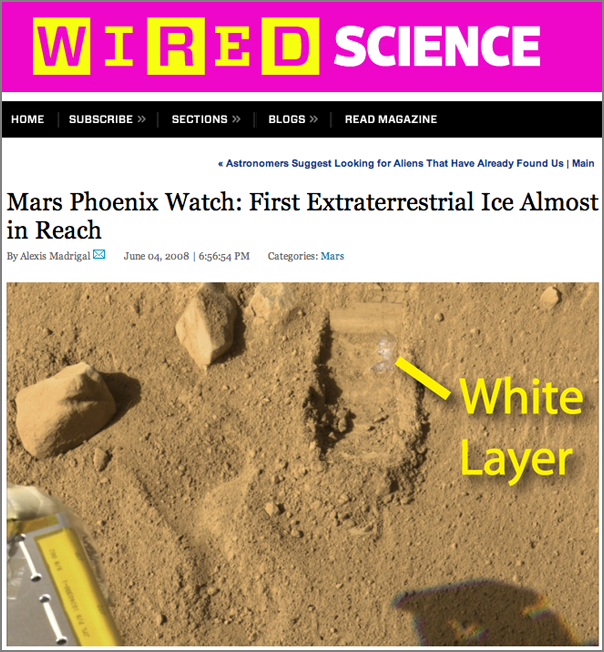
Nice to see my annotation skills in Ilustrator make it to Wired for the color image. Yes, it was only recently that I learned how to use drop shadows. The second figure shows off Steve's Illustrator skills.
Today was also my first day doing the graphics for the press briefing. Thanks to Shigeru for looking of my shoulder and for teaching me the basics of Final Cut Pro.
Check out the new Viz image that was presented by Carol!
238784main_viz-4-scoops-v4.jpg
PowerPoint to PDF did cause me trouble. Why does it put clipping plains around everything? And why can't it keep text together?
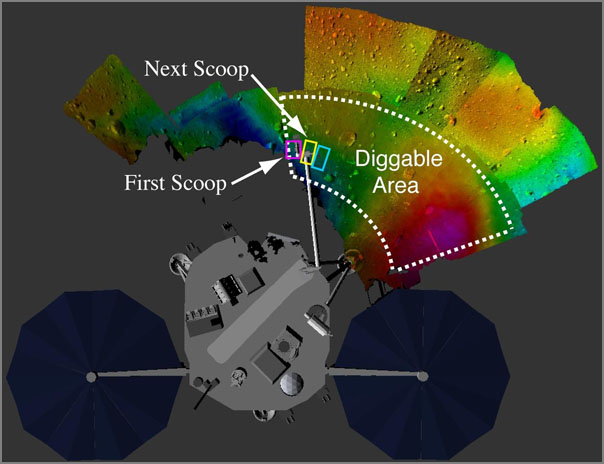

Nice to see my annotation skills in Ilustrator make it to Wired for the color image. Yes, it was only recently that I learned how to use drop shadows. The second figure shows off Steve's Illustrator skills.
Today was also my first day doing the graphics for the press briefing. Thanks to Shigeru for looking of my shoulder and for teaching me the basics of Final Cut Pro.
Check out the new Viz image that was presented by Carol!
238784main_viz-4-scoops-v4.jpg
PowerPoint to PDF did cause me trouble. Why does it put clipping plains around everything? And why can't it keep text together?

06.03.2008 14:58
IP address
I just learned how to use iperf for
measuring bandwidth and whatismyipaddress.com for
getting a network IP for a NAT'ed wireless laptop without having to
run any tracing commands.
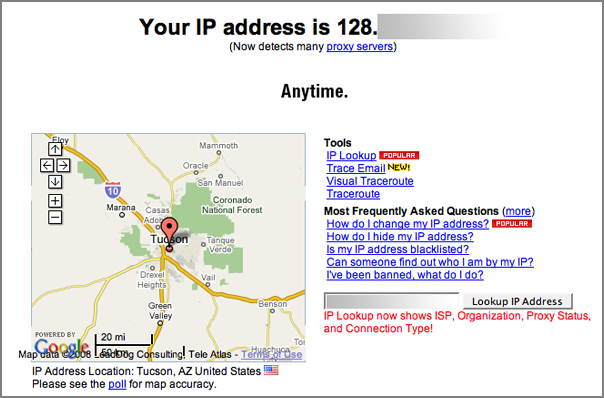

06.03.2008 08:26
Two upcoming excercises in the Seacoast area
Two upcoming excercises in NH:
The first is Frontier Sentinel, June 9-13:
U.S., Canadian forces heading to N.H. for training exercise [seacoast online]
The first is Frontier Sentinel, June 9-13:
U.S., Canadian forces heading to N.H. for training exercise [seacoast online]
... About 3,000 people are expected to participate in next week's training exercise, responding to a mock underwater mine explosion near Portsmouth. The goal is to practice, evaluate and recommend improvements for multi-agency responses to maritime security threats. Officials say they'll have a chance to see what works and what needs polishing when it comes to the two nations' ability to protect and defend North America as a whole. ...And second, there is a submerged oil response drill on June 16.
06.02.2008 21:27
Dual Quad Core Mac
I've been working on new server
today...
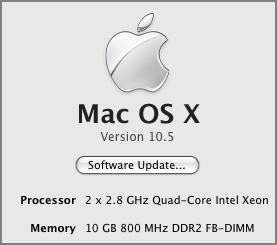
and I've been doing a pretty good job of stress testing it...

This machine will likely run our 5 projector, 60 ft wide screen in the SOC.

and I've been doing a pretty good job of stress testing it...

This machine will likely run our 5 projector, 60 ft wide screen in the SOC.
06.02.2008 18:38
Larry Mayer in Parade Magazine
Art just pointed me to an article in
Parade Magazine about Larry Mayer and the Law of the Seas mapping.
The Race To Own The Arctic
... This summer, American scientists will be charting the sea floor north of Alaska on a Coast Guard icebreaker. Chief scientist Larry Mayer says that hell always remember two sights from last years voyage, when the ice had shrunk so much that the ship was able to research at least 100 miles farther north than was previously possible. He was excited by the first sight: the sea bottom captured on his computer screen. The floor was pocked with 300-foot-wide holes, an occurrence that usually indicates escaping natural gas. ...
06.02.2008 08:51
Wired Twitter Phx interview
Wired
Science Scores Exclusive Twitter Interview with the Phoenix Mars
Lander

...
Since early May, @MarsPhoenix has put out more than 130 updates
ranging from the technical ("FSW is written in 'C'. From the hip it
was somewhere between 30,000 and 60,000 SLOC. Not open source.") to
the celebratory ("Cheers! Tears!! I'm here!").
...
We got an exclusive interview with the Lander itself to catch up with
the personal life of this robotic lander carrying out a heroic mission
millions of miles from home.
...
Not the iphone in the RA scoup in the picture 
06.01.2008 22:24
Paper says too much salt on Mars for life
Thanks to Jeff for pointing me to
this article in Science: Water
Activity and the Challenge for Life on Early Mars [science] by
Tosca, Knoll, and McLennan:
In situ and orbital exploration of the martian surface has shown that acidic, saline liquid water was intermittently available on ancient Mars. The habitability of these waters depends critically on water activity (Formula), a thermodynamic measure of salinity, which, for terrestrial organisms, has sharply defined limits. Using constraints on fluid chemistry and saline mineralogy based on martian data, we calculated the maximum Formula for Meridiani Planum and other environments where salts precipitated from martian brines. Our calculations indicate that the salinity of well-documented surface waters often exceeded levels tolerated by known terrestrial organisms.I haven't read more than the abstract yet, but that is a pretty bold abstract.
